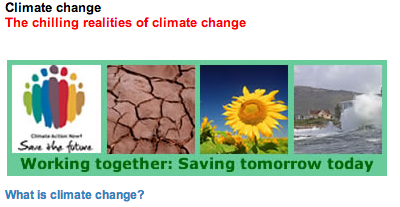

The earth’s climate is always changing and several centuries ago the causes of this change would have been primarily natural in origin. Apart from increasing average temperature, climate change also includes changes in rainfall patterns and in extreme weather events that lead to things like floods and droughts.
Nowadays, although natural changes in the climate continue to occur, the term ‘climate change’ is generally used when referring to changes in climate which have been identified since the early part of the 1900s.
Many of the causes of these changes are related to humanity’s emissions of greenhouse gases.
Rising levels of greenhouse gases, such as carbon dioxide, are already changing the climate and are expected to continue to do so throughout the 21st century and beyond. However, there are many uncertainties about the scale and impacts of climate change – particularly at the regional level.
What is certain, however, is that climate change is likely to have a significant impact on the global environment through increases in temperature; increases in sea level; changes in levels and patterns of precipitation such as rainfall, snow and sleet; and changes in the severity and frequency of extreme weather conditions such as droughts and floods.
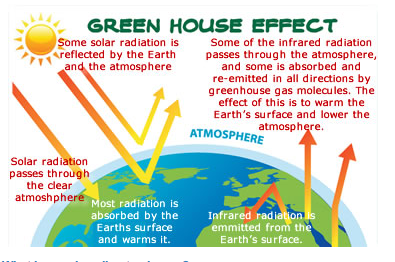

What is causing climate change?
- An increase in the atmospheric concentrations of gases known as greenhouse gases, is a major cause for the steady rise in average global temperatures.
- Greenhouse gases are released into the atmosphere when we burn fossil fuels like coal, oil, petrol, diesel and natural gases.
- Human activities, such as chopping down forests (deforestation), also reduce the earth's natural ability to absorb greenhouse gases.
Some facts about climate change:
The impact of climate change is already felt by both people and the environment throughout the world.
Numerous changes resulting from climate change have already been observed:
- measured increases in the average global temperature
- measured rises in the average global sea level
- reduced snow cover in the northern hemisphere
- significantly increased rainfall in eastern parts of North and South America, as well as northern Europe and northern and central Asia
- the frequency of heavy rainfall events has increased over most land areas - consistent with warming and increases of atmospheric water vapour
- drying in the Sahel, the Mediterranean, southern Africa and parts of southern
- Asia
- more intense and longer droughts observed since the 1970s, particularly in the tropics and sub-tropics
- widespread changes in extreme temperatures have been observed
- cold days, cold nights and less frequent frost
- hot days, hot nights, and more frequent heatwaves.
Why should I worry about climate change?
If we do nothing, then by 2100, we can expect the following consequences:
- Coastal regions will experience a rise in temperature of between 3 ° C and 4 ° C.
- The interior will experience a rise in temperature between 6° C and 7° C.
- Climate change will have a serious impact on biodiversity, which is the variety of life around us - from the largest animal to the smallest plant.
- Commercial forestry is vulnerable because of increased frequency of wildfires and decreasing availability of water in many areas.
- Increase in diseases such as cholera, which are associated with extreme weather events.
- There will be more extreme weather events such as flooding, storms and drought.
Why should we be worried about climate change?
- Many South Africans are vulnerable to extreme climate conditions because of poverty, disease and poor housing and living conditions.

- In many areas, South Africa already has low and unreliable rainfall.
- Most of our surface water resources are already fully allocated.
What is Government doing?
South Africa’s Climate Change Response Policy will embody Government’s commitment to:
- a fair contribution to stabilising global greenhouse gas concentrations in the atmosphere
- protecting the country and its people from the impacts of unavoidable climate change
- presenting government’s vision for an effective climate change response and the long-term transition to a climate-resilient and low-carbon economy and society
- a vision based on government’s commitment to sustainable development and a better life for all.
A climate-resilient, low-carbon economy and society must:
- build up resilience to resist the effects of climate change
- reduce greenhouse gases.
In the long-term, the goal is to transform the economy by shifting from an energy-intensive path to a climate-friendly path as part of a pro-growth, pro-development and pro-jobs strategy.
What can I do about
Climate change?
We can’t stop climate change on our own, but all of us can make a contribution by changing the way we live. We can all play a part in lessening human impact on climate and reversing the effects of climate change:
- Plant indigenous trees
- trees absorb carbon dioxide from the air and use it as their energy source, producing oxygen for us to breathe.
- Recycle
- recycling plastic, glass and paper products. Recycling paper saves trees and reduces the energy used in paper manufacturing.
- Save water
- don’t use more water than you really need
- don’t let water run while shaving, brushing teeth or washing vegetables,
- fix leaking taps
- shower rather than bath.
Save electricity
There are many ways to save energy in our daily lives. The following is a short list of things we can do.
- unplug or turn off all electronic equipment when not in use, including lights, TVs, heaters, fans and kitchen appliances
- select the most energy-efficient appliances.
- install a solar water heater
- use gas for cooking
- insulate your house
- use less hot water; wash your laundry in cold or warm, instead of hot water
- set your geyser’s thermostat on between 50 °C 60 °C
- dry clothes on a washing line instead of using a tumble dryer
- Switch to energy-saving light bulbs. Replace all your old light bulbs with energy-saving compact fluorescent light bulbs. This can save up to 80 per cent on your next electricity bill and lasts up to eight times longer.
Change the way you travel
- use your car less frequently; rather use public transport, walk, jog or cycle if you can
- ensure that your car is in good running order
- maintain proper tyre pressure to maximise your vehicle’s petrol consumption
- when you buy a car, choose an energy-efficient one to reduce you petrol consumption and emissions.
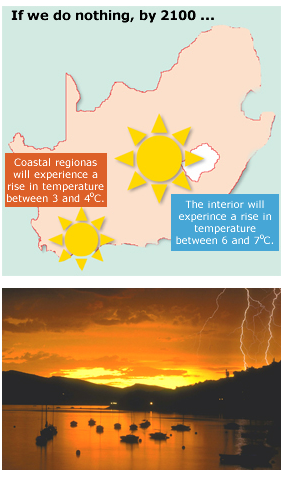
- join a lift club.
Why do we need an international agreement?
No country can combat climate change on its own; the whole world needs to work together to make their fair contribution to mitigation efforts. South Africa’s greenhouse emissions are a small fraction of the global emissions – In 2005, it was only 0,98 per cent of global emissions. If South Africa reduced its emissions by 20 per cent and China and the USA increased their emissions by 0,6 per cent, global emissions would remain the same.
So even if South Africa does everything in its power to reduce its greenhouse gas emissions to zero, but the rest of the world carries on regardless, South Africa will still experience the full impacts of climate change.
The South African government will continue to engage actively and meaningfully in international climate change negotiations, specifically the United Nations Framework Convention on Climate Change (UNFCCC) negotiations.
This will help us to secure a binding, multi-lateral international agreement that will effectively limit the average global temperature increase to at least below 2°C above pre-industrial levels. South Africa’s international engagement with the UNFCCC process.
Article 3.1 of the UNFCCC states that “Parties should protect the climate system for the benefit of present and future generations of humankind, on the basis of equity and in accordance with their common, but differentiated responsibilities and respective capabilities…” Articles 3 and 4 compel parties to take actions to mitigate climate change.
-Source: Department of Environmental Affairs
What is the greenhouse effect?
The temperature of the Earth is determined by the balance of energy coming in from the sun in the form of visible radiation (sunlight) and energy being lost from the surface of the Earth to space.
Energy coming from the sun passes through the atmosphere and warms the Earth – but the emitted infra-red radiation coming from the Earth’s surface is partly absorbed by gases in the atmosphere and some of it is re-emitted downwards, further warming the surface of the Earth and the lower levels of the atmosphere.
This effect has been called the greenhouse effect because of a similar effect caused by glass in a greenhouse: it lets sunlight into the greenhouse but in turn traps a portion of infra-red radiation (heat) inside the greenhouse.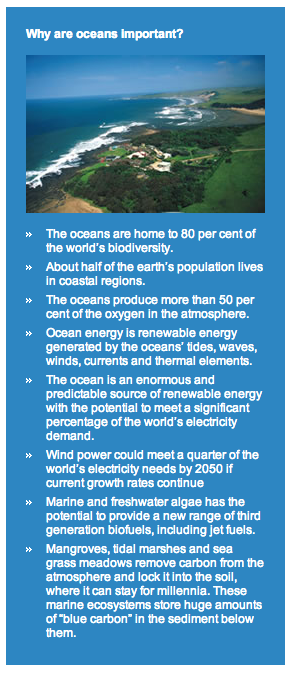
The change in balance between radiation coming into the atmosphere and radiation going out is known as radiative forcing. A positive radiative forcing tends on average to warm the surface of the earth; negative forcing tends on average to cool the surface.
Greenhouse gases
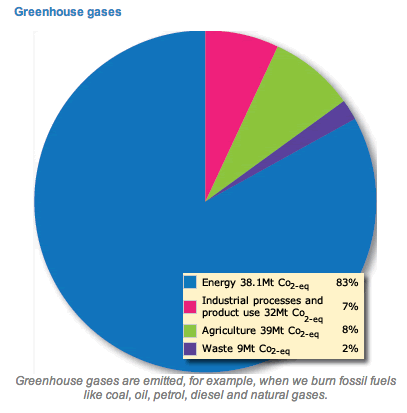
The most important greenhouse gases in the atmosphere (in terms of this effect) are: carbon dioxide, methane, nitrous oxide, hydrofluorocarbons, perflurocarbons and sulphur hexafluoride.
Carbon dioxide: this is the most important of the greenhouse gases released by human activities. It is the main contributor to climate change because of the quantities released, especially through the burning of fossil fuels.
When fossil fuels are burned, the carbon content is oxidised and released as carbon dioxide. Every tonne of carbon burned produces 3,7 tonnes of CO2. The global consumption of fossil fuels is estimated to release 22 billion tonnes of CO2 into the atmosphere every year –and the amounts are still climbing.Department of Environmental Aff



 Facebook
Facebook Twitter
Twitter WhatsApp
WhatsApp